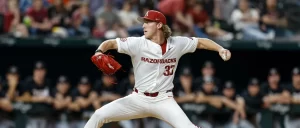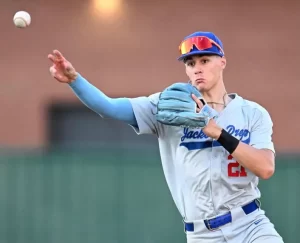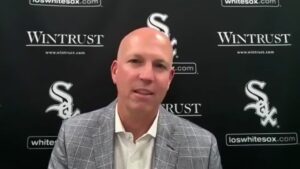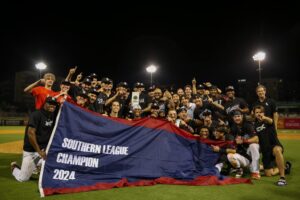2019 White Sox Draft Review: Observations and Takeaways
Taking the Best Player Available
Decision makers in every sport speak endlessly and emphatically about how imperative it is for their club to select the “best player on the board” when determining how to spend a draft pick. While it’s subjective and arbitrary, the Chicago White Sox did just that on the first night of Major League Baseball’s Rule 4 draft.
College catcher Adley Rutschman and prep shortstop Bobby Witt Jr. were the first two players off the board and they were likely the top two prospects on the personal board of the White Sox as well. We’ll never know for a fact how that board lined up but we do know that the organization ultimately settled on California first baseman Andrew Vaughn as the best player for them.
The former Golden Bear was a consensus top-five player in the draft with some analysts placing him as high as No. 2 overall. In 156 games at Cal, Vaughn hit .377/.495/.695 with 50 homers and 162 RBI in almost 730 plate appearances. In his time at Berkeley, Andrew posted a .318 ISO with a wOBA of .518. He has an advanced approach from the right side with a 15.9% walk rate and a strikeout rate of only 9.9%.
Our Ken Sawilchik had the story on draft night. Vaughn was the PAC-12 Freshman of the Year in 2017 and won the Golden Spikes Award as a sophomore in 2018. After the selection was made, Director of Amateur Scouting Nick Hostetler called Vaughn, “One of the most prestigious hitters in the history of college baseball.”
3. White Sox: Andrew Vaughn, 1b, California. Best pure bat in the draft, going to mash and do it with power to all fields. Impact middle of the order bat. Limited to 1B, but bat should be so good that it doesnt matter. #MLBDraft
— Brian Sakowski (@B_Sakowski_PG) June 3, 2019
This is one of those can’t-miss bats. He’s gonna hit for both power and average in the big leagues, for a long time. The draft can be a crapshoot, sure… but this one’s a slam dunk. Go ahead, @OldTakesExposed, file away this tweet. I dare you. https://t.co/xS1xRNbF3N
— Aaron Fitt (@aaronfitt) June 3, 2019
Hostetler says Vaughn’s elite exit velocities with wood and aluminum bats gave the White Sox confidence that his power will translate to pro ball despite a shorter stature
— James Fegan (@JRFegan) June 4, 2019
Vaughn is a very safe prospect in the sense that he should be able to hit and move quickly through the minor leagues. There have been some factors of detraction in regards to the slugger though. Vaughn is under 6’0″ tall, bats right handed and will most likely be relegated to first base as a professional. Picks in the top 10 and more importantly in the top three usually go towards athletic up-the-middle players and pitchers instead of the profile that Vaughn provides.
It would be easy for a scouting department to look at the negatives and disregard positive traits in order to fall on historical superlatives. There are times in a scouting department when the gut should be trusted. It’s important not to overanalyze and outthink the scouting process.
In Ben Reiter’s fantastic look at the Houston Astros’ organization in his book Astroball: The New Way To Win It All, a blackjack reference is used in regards to overthinking the scouting process. Sometimes there are minor issues and red flags that come up during the process, but the theory in the book is that when scouting, a staff should always “hit on 16 whether it feels right or not.”
Vaughn has perceived shortcomings but the data is elite and the scouts all love him. The White Sox hit on 16 and they’re hoping to reap the rewards of that decision in short order.
Keith Law of ESPN believes that Vaughn was the second best player in the draft class and that his “optimized swing using hand and elbow strength” are primary reasons to be intrigued. The veteran prospect writer isn’t concerned about Vaughn’s stature and references Alex Bregman, Jose Altuve and Andrew McCutchen in the video below.
Strategy Change
In the week leading up to the draft, speculation was rampant about a shifting strategy in the White Sox’s draft room. Part of this perceived plan entailed using the third overall pick on an under-slot option such as Georgia prep CJ Abrams.
It was reported by multiple outlets though that Nick Hostetler and his lieutenants were looking to add prep pitching and up-the-middle performers throughout the draft class. It has been well documented that during Hostetler’s tenure in charge, the White Sox have employed a draft strategy heavily reliant upon college players.
His insistence about his desire for prep talent was tough to take at face value in recent years with the actual picks shedding some doubt on his words. In his first three seasons as the lead voice in the draft room, the franchise only used four top-10 round selections on prep players. From 2016-2018, the White Sox made 31 picks in the top 10 rounds and 27 of those were college players.
After Tuesday’s second day, Hostetler said, “This is, what, my 19th year, 20th year in scouting? This is probably the oddest draft I’ve ever been a part of. Just from what we did and how we decided to manage our pool, it was definitely a little bit different than anything I’ve ever been a part of in the past, and I think for most of our guys too.”
In the wake of completing his fourth draft as head of scouting, the veteran evaluator made the rounds on some podcasts and with the print media as well. Similarly to his appearance on the NBC Sports podcast with Chuck Garfien, Hostetler told our editor Clinton Cole about his club’s shifting philosophy on the FutureSox podcast. Hostetler explained that his staff had some important decisions to make after the first night of the draft. He told FutureSox that a lack of depth throughout the class contributed to his club’s shift that was deemed unusual by some.
Hostetler confirmed that RHP Matthew Thompson was a target of theirs with the 45th pick. Coming away with Vaughn and Thompson after the first night of the draft was an ideal outcome for the scouting staff.
Hostetler also admitted that the surprising fall of righty Andrew Dalquist led to a late evening on Monday. Once Dalquist didn’t get selected, the scouting staff and front office constructed a plan that involved selecting and signing the Californian prep. With a rumored price tag of over $2 million, Dalquist would likely require more than the slotted amount of $755K that matches the 81st pick.
The White Sox used their next pick on another high school talent in Mississippi outfielder James Beard. Those picks ultimately forced Hostetler’s staff to serve two masters at once. With a bonus pool of close to $11.6 million at their disposal, much of that would be dispensed to the first four players chosen in this class. In order to reach agreement with the selections, the club used picks in rounds 5-10 on college seniors due to their lack of leverage in the process.
The “on-the-fly” strategy employed by the White Sox is a unique one, but one that has been praised by writers and fans nonetheless. The college players chosen in rounds 5-10 all have valuable skills to offer the organization. They just come at a cheaper cost for the club and allow the deployment of over-slot money to be used in rounds 1-4.
The prep players that were chosen have really high upside and unlike past years, the draft lacked diamonds in the rough after the fourth round, according to Hostetler. He mentioned that his staff thought this was the best use of resources. He didn’t see college pitching comparable to picks of the past like Bernardo Flores, Kade McClure and Jimmy Lambert as options late on day two.
Infusion of Prep Talent
In 2018, the White Sox added five high school players to their system via the draft. Shortstop Lency Delgado was taken out of a Miami area high school in the fourth round and Georgia outfielder Cabera Weaver was selected in Round 7. Day three picks were used on Puerto Rican SS Kelvin Maldonado, catcher Gabriel Ortiz and Michigan prep infielder Bryce Bush.
Bush signed for $290K and made an impact immediately forcing his promotion to full season ball this year. Weaver displayed his speed and defensive skills while posting a 112 wRC+ in the AZL.
Thompson and Dalquist will likely report to Arizona to play for the Lo-Rookie affiliate and their innings counts will be something to monitor. Both pitchers are athletic strike throwers with frames that could handle more weight. Hostetler said that they both have the upside to become frontline starters in the future. Our Mike Rankin completed the draft profile on Dalquist and I wrote about Thompson here.
White Sox take Matthew Thompson, one of the high-upside prep arms remaining. Highly-projectable build with loud arm speed, into the mid-90’s with flashes of a plus breaking ball.
— Brian Sakowski (@B_Sakowski_PG) June 4, 2019
Andrew Dalquist was one of the most impressive prep arms in SoCal this year, in a relatively down year on the high school side. Great athleticism, solid stuff across the board, three-pitch mix. #MLBDraft
— Carlos Collazo (@CarlosACollazo) June 4, 2019
After going college at 3, the White Sox are stocking up on high-upside prep players. James Beard is an 80 runner, plays CF and has impact upside there, bat speed and physicality project, definitely an upside guy
— Brian Sakowski (@B_Sakowski_PG) June 4, 2019
With pick 110 in the 4th round, the White Sox selected the speedster James Beard. In addition to preparing the team’s meals in Arizona, he’ll have plenty of opportunities to moonlight in centerfield. Possessing 80-grade speed, Beard is the fastest player in the draft class. He was much better with the bat late in the season and showed hand strength and bat speed that could equate to average power and a solid hit tool in the future.
ESPN’s Keith Law ranked the Mississippi outfielder as the No. 58 player overall in the draft class. Adding Thompson, Dalquist and Beard is an infusion of prep talent and a change of pace for the organization in recent years. Hostetler has spoken of the need to “get younger” and he executed that plan. It’s also important to continually create a critical mass of players at every level and the talent base at the rookie affiliates will be strong and littered with prospects that fans can dream on.
Catcher Victor Torres from the International Baseball Academy in Puerto Rico was selected in the 11th round. The 12th round pick was used on outfielder Misael Gonzalez Acosta out of the Leadership Christian Academy, also in Puerto Ric0.
Torres is a 6-foot, 175-pound backstop known for his defense, according to Perfect Game. He’s a 6.64 runner with room for growth and he shows advanced skills behind the plate. Hostetler said that he can “really flat out catch and throw..it’s elite and plus across the board.”
Acosta was a bit more of an unknown, but he attended the White Sox’s workout at Guaranteed Rate Field prior to the draft. Hostetler called him an 80-grade runner that plays centerfield and showed scouts some power potential in the workout. Both of these players are expected to sign and should begin their baseball careers in the AZL.
2019 C Victor Torres of IBAHS is WORKING behind the dish tonight. Good work w/mitt is getting those borderline strike calls .Impressive footwork and a strong arm, he has gunned down 2 n picked off 2 @IBAHS1 pic.twitter.com/ZqqHwrrgyH
— Prospect Wire (@ProspectWire) August 12, 2018
11th rounder Victor Torres: He can really flat out catch and throw….it’s elite and plus across the board
12th rounder Misael Gonzalez Acosta: The bat is premium. Similarly to (James) Beard, he can flat out fly. 80 grade speed.
— Rob Young (@RobertHYoung) June 7, 2019
Every year teams take HS players late in the draft and try to move $ around to convince them to sign. 18′ 33rd rounder Bryce Bush was a surprise sign and mashed in his pro debut. The 2019 #WhiteSox draft have a number of late prep guys to follow closely…
— Rob Young (@RobertHYoung) June 7, 2019
Illinois 3B DJ Gladley (16th rd), Oklahoma OF Logan Glass (22nd), Texas OF Caeden Trenkle (28th), Missouri OF Chase Krogman (34th), and Texas OF Logan Britt (35th). Sources indicate Sox are close to signing at least two from this group. Definitely improves the draft haul
— Rob Young (@RobertHYoung) June 7, 2019
The White Sox also used more draft capital on day three by reaching into the prep ranks again. DJ Gladney is a member of the White Sox ACE program, but Hostetler told us that his presence there was just a tertiary factor in his selection. Perfect Game USA calls him “long and projectable with a strong frame that has room for more growth.” The 6-foot-3, 195-pounder from Illiana Christian High School impressed the decision makers at a recent workout. DJ displays big power potential and should be signable despite his Eastern Kentucky commitment.
#ACGames18 #WhiteSox 3B DJ Gladney’s home run Thursday 8/9/18 pic.twitter.com/1VMMrFiCl3
— Kim C (@Cu_As) August 10, 2018
Logan Glass is a 6-foot-4, 215-pound right-handed hitting centerfielder from Mustang High School in Oklahoma. He’s got an athletic frame and can really run and throw. Logan hit .522 with 11 homers and 14 stolen bases this season. He is a Kansas commit, but there have been some indications that he may be interested in signing with the White Sox.
Mustang’s Logan Glass has been drafted by the Chicago White Sox in the 22nd round (650th pick) as a center fielder. “It hasn’t hit me yet,” Glass said. “Yeah, I’m going.” #okpreps #StangNation #WhiteSox pic.twitter.com/XLjlJB4J8K
— Brody Feldmann (@BFeldo14) June 5, 2019
In addition to the Puerto Rican teenagers at the top of day three, Hostetler gave the impression that the Sox were comfortable with their chances to sign two additional prep players from this crop. Gladney (16th round) and Glass (22nd round) are the most logical of the bunch.
Lefty hitting outfielder Caeden Trenkle from Hillsboro, Texas, was drafted in Round 28. The 5-foot-10 Oklahoma State commit shows good speed and arm strength. There hasn’t been much news on this front, but it seems like Trenkle is a solid bet to reach campus in Stillwater.
34th rounder Chase Krogman is an outfielder from Liberty High School in Missouri. Perfect Game has a scouting report here. The 5-foot-11, 180-pounder has a commitment to Missouri State, but is said to be weighing his options.
35th rounder Logan Britt from Colleyville Heritage High School has announced that he’ll be heading to Texas A&M this fall and not signing with the club.
Organizational Depth or Even More
The strategy that the White Sox employed in the 2019 draft required them to select more college seniors than usual. College seniors sign for less money and the organization needed to prioritize in different areas.
Much of the remaining draft class will ultimately turn into organizational depth to fill out rosters throughout the system. These players all have traits though and offer something as a reason for why they were selected.
Diamonds in the rough can be found and the Sox have unearthed some major leaguers in recent years on day three. Adam Engel was a 19th round project out of Louisville and while he struggled in the big leagues, making it to the show in the first place is a scouting win. Aaron Bummer is lighting the world on fire out of the bullpen and he was also a 19th round selection. Seby Zavala (12th round) got a big league look this season and Danny Mendick (22nd round) should as well at some point this season.
Here are some guys who could be noteworthy.
Ivan Gonzalez C West Virginia (8th round)
Lots of scouts made it in to see Gonzalez this year because he caught all of first rounder Alek Manoah‘s starts. He’s known more for his defense and game calling ability than his bat and he was a Freshman All-American once upon a time. Gonzalez threw out 44% of would be base stealers for the Mountaineers. He had an outstanding high school career and was under-recruited due to size. His grinder mentality and ability to harness pitchers is what ultimately got him drafted though.
#WVU senior catcher Ivan Gonzalez is heading to the Chicago White Sox. Great defensive player and a key leader for the Mountaineers this season. https://t.co/sh0No7bgIY
— Patrick Kotnik (@PatrickKotnik) June 4, 2019
Caleb Freeman RHP Texas Tech (15th round)
Freeman had a really poor season and he lacked confidence throughout. Nick Hostetler told us on the podcast that he was a big fan of Freeman after seeing him pitch in the Cape Cod League. Hostetler said he was, “90-96 mph with a power breaking ball and commanded and controlled the game out of the bullpen.” Hostetler also mentioned that he has confidence in what the organization’s pitching coaches will be able to do with with Freeman upon entering the organization.
Courtesy of Brian Sakowski
Sammy Peralta LHP University of Tampa (18th round)
Peralta is a southpaw with a live arm who struck out 65 batters in 37 innings this season.
Sammy Peralta is absolutely dealing.
Impressive arsenal. Struck out the side on using his fastball to set up all three Ks on off speed stuff. #WhiteSox #D2baseball @UT_Baseball pic.twitter.com/44V8vtBjX3
— Wayne Cavadi (@UofDWayne) June 6, 2019
Cameron Simmons OF Virginia (20th round)
Simmons was second team All-ACC as a sophomore when he was playing next to former first rounder Adam Haseley. He was thought of as a future first round selection himself, but missed his entire junior season with an injury. Simmons struggled for the Cavaliers this past year, but the tools are still present and he could be a deep sleeper.
The @whitesox selected a guy with all the tools! Congrats to Cameron Simmons! pic.twitter.com/4RsqDg9Phy
— Virginia Baseball (@UVABaseball) June 5, 2019
Hansen Butler RHP North Carolina (25th round)
Butler is a live arm with high walk totals. The fifth-year senior reliever has racked up 29 K and 15 BB in 20 innings. He has 95 K in 69 innings for the Tar Heels in his career. Butler posted a 2.65 ERA in the Cape Cod League back in 2016. He was a former teammate of White Sox’s farmhands Kade McClure and Konnor Pilkington over the summer.
Prospect Pipeline Video
Want to know right away when we publish a new article? Type your email address in the box on the right-side bar (or at the bottom, if on a mobile device) and click the “create subscription” button. Our list is completely spam free, and you can opt out at any time.







I like what the White Sox did with their top-4 picks. Selecting the best college hitting prospect (again!) was a no-brainer at #3. The 3 high ceiling prep players, two SP’s and the fleet CF was equally impressive.
Hopefully the White Sox are not done and will also land 22-year old Cuban SS Yolbert Sanchez next month when the next international signing period begins on July 2nd. Sanchez has been eligible to sign in the current period which ends on June 15th, this coming Saturday.
Between this year’s Rule 4 Draft and the inking of an MLB ready defensive SS, the White Sox could have quite the summer which might become even more fruitful in terms of young talent depending on their course of action by the July 31st trade deadline. They might be tempted to hang on to some potential core veterans as they linger in the AL Wild Card race but fielding offers for the likes of Jose Abreu and Alex Colome could add to their wealth of young talent, especially if it resulted in the acquisition of near-ready MLB prospect capital.
A smart organization would capitalize on their trade assets. Unfortunately, Reinsdorf front offices never do the smart thing. The White Sox could be so much more with a better front office.